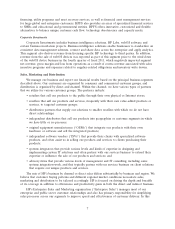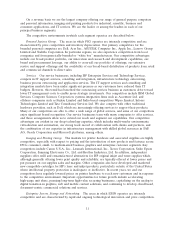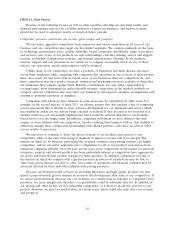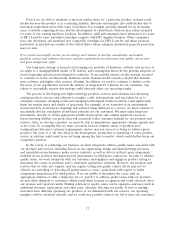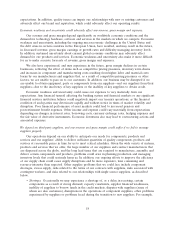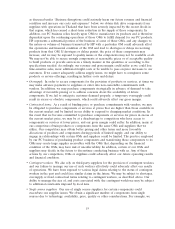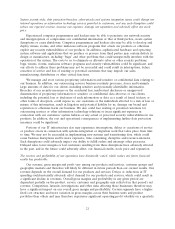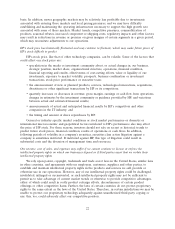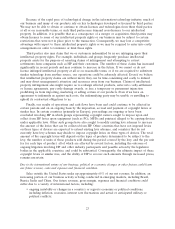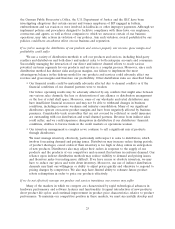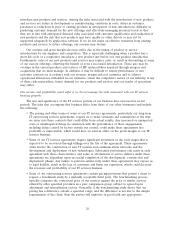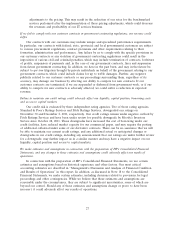HP 2011 Annual Report Download - page 25
Download and view the complete annual report
Please find page 25 of the 2011 HP annual report below. You can navigate through the pages in the report by either clicking on the pages listed below, or by using the keyword search tool below to find specific information within the annual report.Even if we are able to maintain or increase market share for a particular product, revenue could
decline because the product is in a maturing industry. Revenue and margins also could decline due to
increased competition from other types of products. For example, growing demand for an increasing
array of mobile computing devices and the development of cloud-based solutions may reduce demand
for some of our existing hardware products. In addition, refill and remanufactured alternatives for some
of HP’s LaserJet toner and inkjet cartridges compete with HP’s supplies business. Other companies
have also developed and marketed new compatible cartridges for HP’s LaserJet and inkjet products,
particularly in jurisdictions outside of the United States where adequate intellectual property protection
may not exist.
If we cannot successfully execute on our strategy and continue to develop, manufacture and market
products, services and solutions that meet customer requirements for innovation and quality, our revenue
and gross margin may suffer.
Our long-term strategy is focused on leveraging our portfolio of hardware, software and services as
we adapt to a changing/hybrid model of IT delivery and consumption driven by the growing adoption of
cloud computing and increased demand for solutions. To successfully execute on this strategy, we need
to continue to evolve our historically hardware-centric business model towards a model that includes
more software and higher value services offerings. In addition, we need to continue to further evolve
the focus of our organization towards the delivery of integrated IT solutions for our customers. Any
failure to successfully execute this strategy could adversely affect our operating results.
The process of developing new high technology products, services and solutions and enhancing
existing products, services and solutions is complex, costly and uncertain, and any failure by us to
anticipate customers’ changing needs and emerging technological trends accurately could significantly
harm our market share and results of operations. For example, as we transition to an environment
characterized by cloud-based computing and software being delivered as a service, we must continue to
successfully develop and deploy cloud-based solutions for our customers. We must make long-term
investments, develop or obtain appropriate intellectual property and commit significant resources
before knowing whether our predictions will accurately reflect customer demand for our products and
services. After we develop a product, we must be able to manufacture appropriate volumes quickly and
at low costs. To accomplish this, we must accurately forecast volumes, mixes of products and
configurations that meet customer requirements, and we may not succeed at doing so within a given
product’s life cycle or at all. Any delay in the development, production or marketing of a new product,
service or solution could result in us not being among the first to market, which could further harm our
competitive position.
In the course of conducting our business, we must adequately address quality issues associated with
our products and services, including defects in our engineering, design and manufacturing processes
and unsatisfactory performance under service contracts, as well as defects in third- party components
included in our products and unsatisfactory performance by third-party contractors. In order to address
quality issues, we work extensively with our customers and suppliers and engage in product testing to
determine the causes of problems and to determine appropriate solutions. However, the products and
services that we offer are complex, and our regular testing and quality control efforts may not be
effective in controlling or detecting all quality issues or errata, particularly with respect to faulty
components manufactured by third parties. If we are unable to determine the cause, find an
appropriate solution or offer a temporary fix (or ‘‘patch’’) to address quality issues with our products,
we may delay shipment to customers, which would delay revenue recognition and could adversely affect
our revenue and reported results. Finding solutions to quality issues can be expensive and may result in
additional warranty, replacement and other costs, adversely affecting our profits. If new or existing
customers have difficulty operating our products or are dissatisfied with our services, our operating
margins could be adversely affected, and we could face possible claims if we fail to meet our customers’
17


